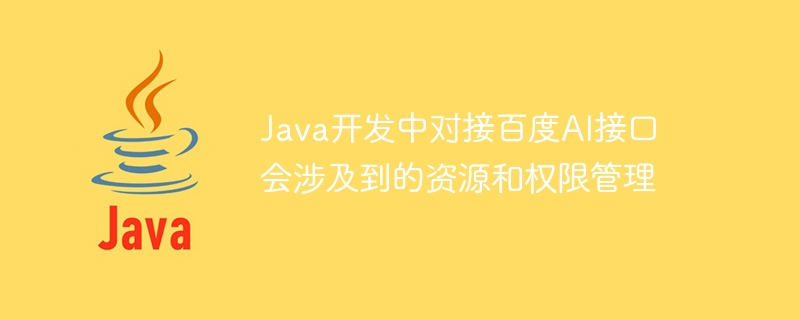Home >Java >javaTutorial >Resource and permission management involved in docking Baidu AI interface in Java development
Resource and permission management involved in docking Baidu AI interface in Java development
- 王林Original
- 2023-08-26 16:07:421006browse

Resource and permission management involved in connecting Baidu AI interface in Java development
As one of the most popular and widely used programming languages, Java is used in various fields All have a wide range of applications. Among them, docking Baidu AI interface has also become an important skill in Java development. However, in the process of connecting and using Baidu AI interface, resource and permission management are essential links. This article will introduce the resources and permission management required for connecting to Baidu AI interface in Java development, and provide corresponding code examples to help readers better understand and apply this process.
Resource management means that when connecting to Baidu AI interface in Java development, certain resources must be allocated to it. Before connecting to Baidu AI interface, you first need to obtain the API Key and Secret Key of Baidu Cloud AI service. The API Key is the key used to identify the user, while the Secret Key is the secret key used to cryptographically sign the request. By sending these two keys to the Baidu Cloud AI server together with the network request, we can make the interface call and obtain the corresponding results.
The following is a sample code that shows how to obtain the API Key and Secret Key required to access Baidu AI interface in Java:
import java.io.BufferedReader;
import java.io.IOException;
import java.io.InputStreamReader;
import java.net.HttpURLConnection;
import java.net.URL;
public class BaiduAIResourceManagement {
private static final String API_KEY = "your_api_key";
private static final String SECRET_KEY = "your_secret_key";
public static void main(String[] args) {
String accessToken = getAccessToken();
System.out.println("Access Token: " + accessToken);
}
private static String getAccessToken() {
String accessToken = "";
try {
URL url = new URL("https://aip.baidubce.com/oauth/2.0/token?grant_type=client_credentials" +
"&client_id=" + API_KEY +
"&client_secret=" + SECRET_KEY);
HttpURLConnection connection = (HttpURLConnection) url.openConnection();
connection.setRequestMethod("GET");
BufferedReader reader = new BufferedReader(new InputStreamReader(connection.getInputStream()));
StringBuilder response = new StringBuilder();
String line;
while ((line = reader.readLine()) != null) {
response.append(line);
}
reader.close();
connection.disconnect();
// 解析返回的 JSON 数据,获取 Access Token
// 示例:{"access_token":"24.83d9bce9876e3897c83928e494ccd98b7.2592000.1629271243.282335-12345678","expires_in":2592000}
String jsonResponse = response.toString();
accessToken = jsonResponse.substring(jsonResponse.indexOf(":") + 2, jsonResponse.indexOf(",") - 1);
} catch (IOException e) {
e.printStackTrace();
}
return accessToken;
}
}The above code accesses the interface of Baidu AI open platform, Use API Key and Secret Key for identity authentication and return the relevant Access Token. This Access Token can be used as a credential for subsequent resource calls.
Permission management refers to how to correctly use and manage the correct resources after obtaining them. When connecting to Baidu AI interfaces, each interface has corresponding usage restrictions, including the number and frequency of calls per day. In order to use resources rationally and avoid exceeding limits, we need to properly control and manage calls.
The following is a simple sample code that shows how to call the text recognition interface of Baidu AI platform:
import com.baidu.aip.ocr.AipOcr;
import org.json.JSONObject;
public class BaiduAIAuthorization {
private static final String APP_ID = "your_app_id";
private static final String API_KEY = "your_api_key";
private static final String SECRET_KEY = "your_secret_key";
public static void main(String[] args) {
AipOcr client = new AipOcr(APP_ID, API_KEY, SECRET_KEY);
// 设置可选参数
HashMap<String, String> options = new HashMap<>();
options.put("language_type", "CHN_ENG");
options.put("detect_direction", "true");
options.put("detect_language", "true");
options.put("probability", "true");
// 调用文字识别接口
String imagePath = "your_image_path";
JSONObject response = client.basicGeneral(imagePath, options);
// 解析返回的 JSON 数据
System.out.println(response.toString(2));
}
}The above code completes the text recognition interface through the Java SDK provided by Baidu AI open platform call. It should be noted that the text recognition interface has a limit on the number of calls and concurrency per day. If the limit is exceeded, the corresponding error message will be returned.
In practical applications, resource and permission management are important aspects of Baidu AI interface calling. Properly using and managing resources and complying with the usage specifications of Baidu AI platform can not only improve the success rate of interface calls, but also protect the security of user data.
Through the introduction and sample code of this article, I believe readers can have a deeper understanding and application of the resource and permission management required to connect to Baidu AI interfaces in Java development. I hope readers can achieve better results when using Baidu AI interface to develop Java applications.
The above is the detailed content of Resource and permission management involved in docking Baidu AI interface in Java development. For more information, please follow other related articles on the PHP Chinese website!

